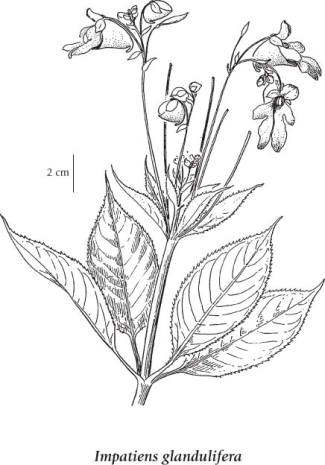policeman's helmet (ornamental jewelweed)
Balsaminaceae (Touch-me-not family)
Introduction to Vascular Plants
Introduction click to expand contents
Policeman's helmet is an introduced summer annual that is native to the Himalayas, but has spread around the world since seeds were first sent from the Himalayas to KEW gardens in England in 1839. In North America it is found in the USA, primarily along the Pacific Coast and in the New England States (CA, CT, ID, MA, ME, MI, MT, NY, OR, VT, WA) and in Canada it is found in eight provinces (BC, MB, NB, NF, NS, ON, PE, QC) (USDA 2010). In British Columbia, it is found primarily in the southern part of the province, around Victoria, in the Fraser Valley, and in southeastern BC
Policeman's helmet is an easily identified species of Impatiens, 0.6 to 2.0 m in height, which produces distinctive white to pink, purple-spotted flowers with short recurved spurs. Flowering occurs from July to September. It can form thick homogeneous stands in moist shady spots along creeks, riverbanks and sloughs and in open sunny ditches. It produces abundant seed in seed capsules that explode when ripe allowing near dispersal and thick growth. The earliest collection record for this species in the UBC Herbarium is 1937, when it was collected at Still Creek, BC by John Eastman. "[Policeman's helmet's] high reproductive rate, early germination, propensity for establishing thick stands, rich nectar production, hardiness, and habitat tolerance and plasticity have allowed it to spread rapidly, dominate landscapes, and compete with and displace native plant species." (Global Invasives Database 2010). |
Species Information click to expand contents
General:
Annual succulent herb; stems erect to ascending, often branched, glabrous, often purplished-tinged, 0.6-2.0 m tall.
Leaves:
Opposite to whorled (at least some of them), stalked, egg-shaped to elliptic, sharply and closely saw-toothed, 6-15 cm long.
Flowers:
One to several in leaf axils, whitish to red, usually purplish-spotted; sepals pouched, with a short recurved spur.
Fruits:
Capsules, elastically dehiscent, 1.5-2.5 cm long, many-seeded.
Illustration click to expand contents

If more than one illustration is available for a species (e.g., separate illustrations were provided for two subspecies) then links to the separate images will be provided below. Note that individual subspecies or varietal illustrations are not always available.
Illustration Source: The Illustrated Flora of British Columbia
Ecology click to expand contents
The table below shows the species-specific information calculated from
original data (BEC database) provided by the BC Ministry of Forests and Range.
(Updated August, 2013)
| Site Information |
Value / Class |
||
|
Avg |
Min |
Max |
|
| Elevation
(metres) |
1204 | 1204 | 1204 |
| Slope
Gradient (%) |
1 | 1 | 1 |
|
Aspect (degrees) |
312 | 312 | 312 |
| Soil
Moisture Regime (SMR) [0 - very xeric; 4 - mesic; 8 - hydric] |
8 | 8 | 8 |
| Modal
Nutrient Regime
Class |
B | ||
| #
of field plots species was recorded in: |
1 | ||
| Modal
BEC Zone Class |
SBS | ||
|
All BEC Zones (# of stations/zone) species was recorded in |
SBS(1) | ||
|
Source:
Klinkenberg 2013
|
|||
Habitat and Range click to expand contents
Status Information click to expand contents
Synonyms click to expand contents
Synonyms and Alternate Names:
Impatiens roylei Walp.
Taxonomic Keys click to expand contents
Taxonomic Key to Impatiens
1. Pouched sepals not spurred......................................I. ecalcarata 1. Pouched sepals spurred. 2. Leaves opposite or whorled (at least some of them), finely saw-toothed; flowers blue to purple or purplish-pink or sometimes white............................ I. glandulifera 2. Leaves alternate, coarsely saw-toothed; flowers orange or yellowish. 3. Spurs of the sepals straight, directed backward.......................................I. parviflora 3. Spurs of the sepals curved or hooked. 4. Flowers less than 2 cm long, without spots..........................I. aurella 4. Flowers more than 2 cm long, spotted, mottled or sparingly flecked. 5. Flowers orange, brown-spotted, or -mottled.........................I. capensis 5. Flowers yellow, sparingly flecked with brownish purple........................I. noli-tangere |
Taxonomic Notes click to expand contents
A combination of factors including a high reproductive rate, aggressive seed dispersal, early germination, and high nectar production which attracts pollinators allows this species to out-compete and displace native species. It is very attractive to pollinators (Bartomeus et al. 2010). For further information about control of this species, visit the Great Vancouver Invasive Plant Council web site.
References: Bartomeus, Ignasi, Montserrat Vilà and Ingolf Steffan-Dewenter. 2010. Combined effects of Impatiens glandulifera invasion and landscape structure on native plant pollination. Journal of Ecology 98 (2): 440 - 450. |